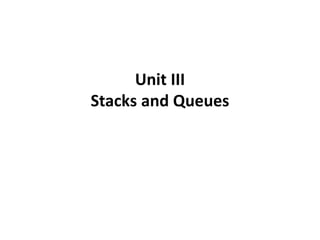
Stacks and Queue,Concept of Stack,LIFO,Fifo,
- 1. Unit III Stacks and Queues
- 2. Unit III Stacks and Queues COs Mapped – CO2, CO5 • Concept of stack and queues as ADT, • Implementation of stacks using sequential and linked organization, • linear queue, • circular queue using sequential and linked organization, • Priority Queue, • Deque, • Application of stack for expression conversion, evaluation, recursion and backtracking • Application of queue in job scheduling
- 3. What is a Stack? • A Stack is a linear data structure that follows the LIFO (Last-In-First-Out) principle. • Stack has one end, whereas the Queue has two ends (front and rear). • It contains only one pointer top pointer pointing to the topmost element of the stack.
- 4. • Whenever an element is added in the stack, it is added on the top of the stack, and the element can be deleted only from the stack. • In other words, a stack can be defined as a container in which insertion and deletion can be done from the one end known as the top of the stack.
- 5. Some key points related to stack • It is called as stack because it behaves like a real-world stack, piles of books, etc. • A Stack is an abstract data type with a pre- defined capacity, which means that it can store the elements of a limited size. • It is a data structure that follows some order to insert and delete the elements, and that order can be LIFO or FILO.
- 6. Working of Stack • Stack works on the LIFO pattern. As we can observe in the below figure there are five memory blocks in the stack; therefore, the size of the stack is 5. • Suppose we want to store the elements in a stack and let's assume that stack is empty. We have taken the stack of size 5 as shown below in which we are pushing the elements one by one until the stack becomes full.
- 8. • Since our stack is full as the size of the stack is 5. • In the above cases, we can observe that it goes from the top to the bottom when we were entering the new element in the stack. • The stack gets filled up from the bottom to the top.
- 9. • When we perform the delete operation on the stack, there is only one way for entry and exit as the other end is closed. • It follows the LIFO pattern, which means that the value entered first will be removed last. In the above case, the value 5 is entered first, so it will be removed only after the deletion of all the other elements.
- 10. Stack ADT in Data Structures • Let us now see the data object, operations and axioms associated with stack. • Any sets of elements that are of the same data type can be used as a data object for stack • E.g.stack of integers, stack of students etc.
- 13. Stack ADT in Data Structures • The abstract datatype is special kind of datatype, whose behavior is defined by a set of values and set of operations. • The keyword “Abstract” is used as we can use these datatypes, we can perform different operations. • But how those operations are working that is totally hidden from the user. • The ADT is made of with primitive datatypes, but operation logics are hidden.
- 14. Here we will see the stack ADT. These are few operations or functions of the Stack ADT. 1. isFull(), This is used to check whether stack is full or not 2. isEmpry(), This is used to check whether stack is empty or not 3. push(x), This is used to push x into the stack 4. pop(), This is used to delete one element from top of the stack 5. peek(), This is used to get the top most element of the stack 6. size(), this function is used to get number of elements present into the stack
- 15. Standard Stack Operations The following are some common operations implemented on the stack: 1. push(): When we insert an element in a stack then the operation is known as a push. If the stack is full then the overflow condition occurs. 2. pop(): When we delete an element from the stack, the operation is known as a pop. If the stack is empty means that no element exists in the stack, this state is known as an underflow state. 3. isEmpty(): It determines whether the stack is empty or not. 4. isFull(): It determines whether the stack is full or not.' 5. peek(): It returns the element at the given position. 6. count(): It returns the total number of elements available in a stack. 7. change(): It changes the element at the given position. 8. display(): It prints all the elements available in the stack.